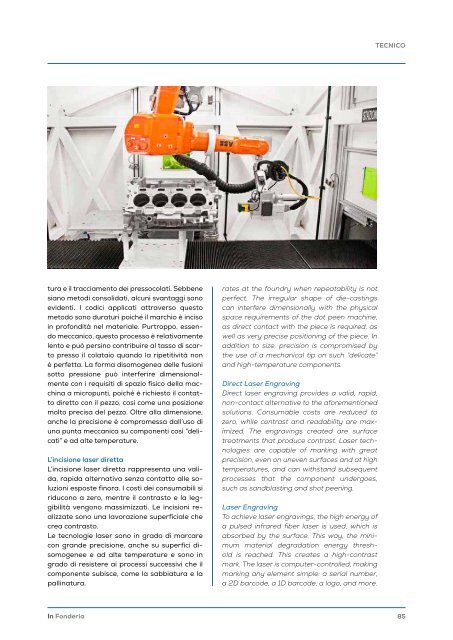In Fonderia 6 2023
Sesto numero del 2023 di In Fonderia
Sesto numero del 2023 di In Fonderia
Create successful ePaper yourself
Turn your PDF publications into a flip-book with our unique Google optimized e-Paper software.
TECNICO<br />
<br />
<br />
tura e il tracciamento dei pressocolati. Sebbene<br />
siano metodi consolidati, alcuni svantaggi sono<br />
evidenti. I codici applicati attraverso questo<br />
metodo sono duraturi poiché il marchio è inciso<br />
in profondità nel materiale. Purtroppo, essendo<br />
meccanico, questo processo è relativamente<br />
lento e può persino contribuire al tasso di scarto<br />
presso il colataio quando la ripetitività non<br />
è perfetta. La forma disomogenea delle fusioni<br />
sotto pressione può interferire dimensionalmente<br />
con i requisiti di spazio fisico della macchina<br />
a micropunti, poiché è richiesto il contatto<br />
diretto con il pezzo, così come una posizione<br />
molto precisa del pezzo. Oltre alla dimensione,<br />
anche la precisione è compromessa dall’uso di<br />
una punta meccanica su componenti così “delicati”<br />
e ad alte temperature.<br />
L’incisione laser diretta<br />
L’incisione laser diretta rappresenta una valida,<br />
rapida alternativa senza contatto alle soluzioni<br />
esposte finora. I costi dei consumabili si<br />
riducono a zero, mentre il contrasto e la leggibilità<br />
vengono massimizzati. Le incisioni realizzate<br />
sono una lavorazione superficiale che<br />
crea contrasto.<br />
Le tecnologie laser sono in grado di marcare<br />
con grande precisione, anche su superfici disomogenee<br />
e ad alte temperature e sono in<br />
grado di resistere ai processi successivi che il<br />
componente subisce, come la sabbiatura e la<br />
pallinatura.<br />
rates at the foundry when repeatability is not<br />
perfect. The irregular shape of die-castings<br />
can interfere dimensionally with the physical<br />
space requirements of the dot peen machine,<br />
as direct contact with the piece is required, as<br />
well as very precise positioning of the piece. <strong>In</strong><br />
addition to size, precision is compromised by<br />
the use of a mechanical tip on such “delicate”<br />
and high-temperature components.<br />
Direct Laser Engraving<br />
Direct laser engraving provides a valid, rapid,<br />
non-contact alternative to the aforementioned<br />
solutions. Consumable costs are reduced to<br />
zero, while contrast and readability are maximized.<br />
The engravings created are surface<br />
treatments that produce contrast. Laser technologies<br />
are capable of marking with great<br />
precision, even on uneven surfaces and at high<br />
temperatures, and can withstand subsequent<br />
processes that the component undergoes,<br />
such as sandblasting and shot peening.<br />
Laser Engraving<br />
To achieve laser engravings, the high energy of<br />
a pulsed infrared fiber laser is used, which is<br />
absorbed by the surface. This way, the minimum<br />
material degradation energy threshold<br />
is reached. This creates a high-contrast<br />
mark. The laser is computer-controlled, making<br />
marking any element simple: a serial number,<br />
a 2D barcode, a 1D barcode, a logo, and more.<br />
<br />
<strong>In</strong> <strong>Fonderia</strong><br />
85














